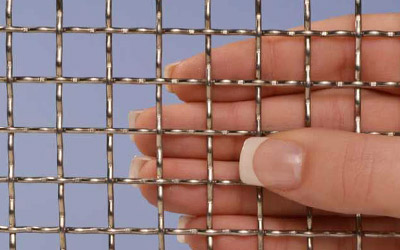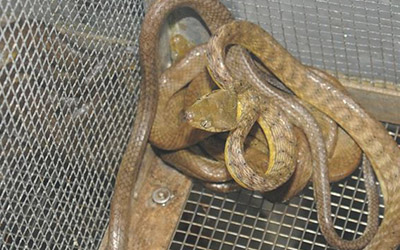Grassy yards and gardens are paradises for snakes because they have all the things they love, such as food and places to hide. You probably don’t want to alter the contents of your garden just to keep snakes out, which is why the best solution is a custom wire mesh fence.
Pest-control fencing can be costly, but the DIY route is both easy and affordable. What’s more, it’s a non-toxic solution that won’t harm either animals or the environment. If you’re wondering how to install a wire mesh snake fence, TWP Inc. has you covered. Check out our top five tips for building a DIY outdoor barrier.
1. Use Aluminum or Galvanized Wire Mesh
 When it comes to snake-proof fencing, your best bet is aluminum or galvanized wire mesh. Aluminum fencing is lightweight and flexible yet strong, durable, and resistant to corrosion. Plus, it’s typically more affordable than other metal mesh products.
When it comes to snake-proof fencing, your best bet is aluminum or galvanized wire mesh. Aluminum fencing is lightweight and flexible yet strong, durable, and resistant to corrosion. Plus, it’s typically more affordable than other metal mesh products.
Galvanized stainless steel hardware cloth is a more heavy-duty option. Galvanization involves dipping into molten zinc, which creates a highly stable and resilient protective coating. It lasts longer than standard steel mesh and holds up under extreme environmental conditions.
2. Select a Small Weave Opening
A small weave opening is essential for wire mesh snake fences. For best results, select metal mesh or hardware cloth with a weave opening no larger than a quarter of an inch. Anything larger might not effectively keep snakes out. When pest-control fencing is ineffective, one of the most common issues is weave openings that are too large.
3. Install the Proper Height and Depth
Another common problem with snake fencing is improper height and depth. So, how high should a wire mesh fence be to keep snakes out? For best results, install a fence that’s at least 30 inches from the ground — even better if it’s a few inches taller. Positioning the metal mesh at a 30-degree angle is also a good idea, as it will help prevent snakes from climbing over.
You’ll also need to make sure you have enough material to bury it several inches underground. We recommend going at least 10 inches below the surface. This will ensure snakes can’t crawl over or under the fence. Additionally, you’ll want to cut or transplant all nearby plants and shrubbery so that snakes can’t use them to get over the fencing.
4. Get Rid of Rodents First
Snakes prey on rodents, so one of the best ways to keep them out of your outdoor space is to take care of your rodent problem first. That being said, wire mesh fencing can be used to exclude mice, rats, vole, and other rodents in addition to snakes.
Aside from a fence, you’ll want to safeguard your house, shed, and trash receptacles from rodents. Wire mesh and hardware cloth can be installed on the lids of your trash and compost bins, as well as around woodpiles in a shed. You may want to move any pet food to an area where pests can’t get to it. It’s also a good idea to cover any access points to your house with rodent-proofing mesh, such as foundation vents, soffit screens, gutters, and your chimney.
5. Contact the U.S. Fish & Wildlife Service
 Before implementing any DIY snake-proofing measures, we suggest contacting the United States Fish and Wildlife Service (FWS) to touch base with a local representative. Some areas have specific rules and regulations pertaining to exclusion and relocation of captured wildlife, including snakes. Although most snakes found in the U.S. are harmless to humans, the FWS recommends researching species native to your area.
Before implementing any DIY snake-proofing measures, we suggest contacting the United States Fish and Wildlife Service (FWS) to touch base with a local representative. Some areas have specific rules and regulations pertaining to exclusion and relocation of captured wildlife, including snakes. Although most snakes found in the U.S. are harmless to humans, the FWS recommends researching species native to your area.
Snake-Control Wire Mesh from TWP Inc.
The pest-control wire mesh and galvanized hardware cloth from TWP Inc. is ideal for DIY snake fencing and rodent exclusion screens. For over 50 years, our women-owned company has been a leading supplier of industrial-grade metal mesh products for both residential and commercial use. Order your snake-control hardware cloth today or contact TWP Inc. about a custom order.
Want to have your pest-control project featured in our online gallery? Post your photos on Instagram with the hashtag #TWPWireMesh.



 When it comes to snake-proof fencing, your best bet is
When it comes to snake-proof fencing, your best bet is  Before implementing any DIY snake-proofing measures, we suggest contacting the
Before implementing any DIY snake-proofing measures, we suggest contacting the